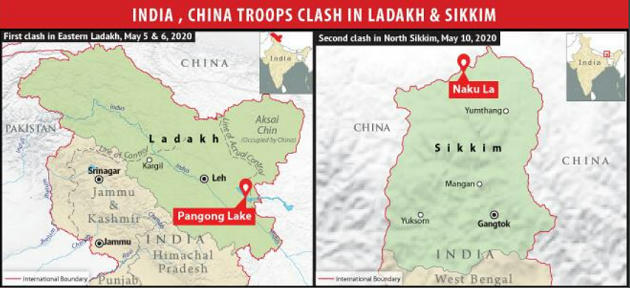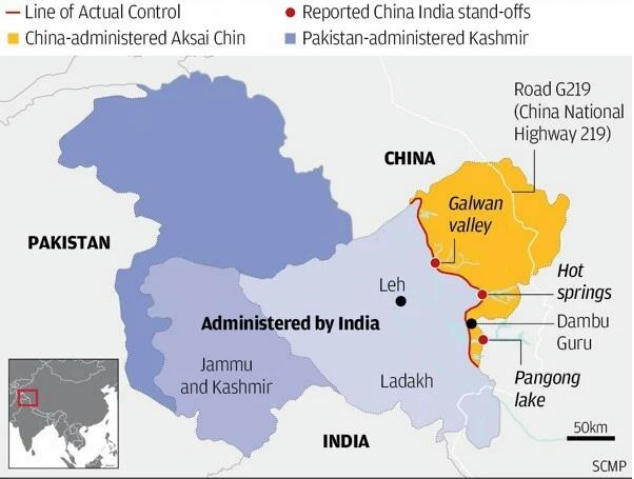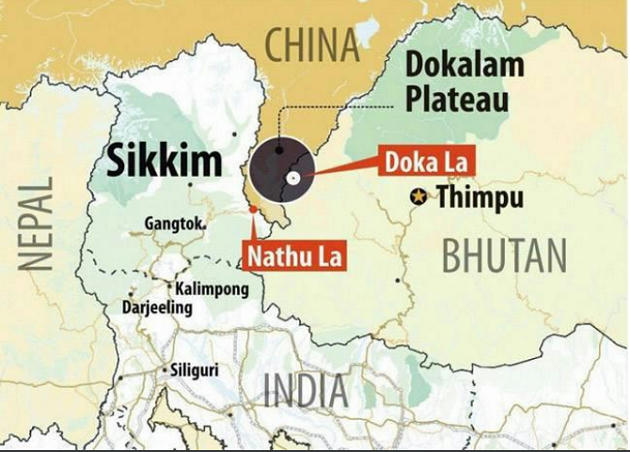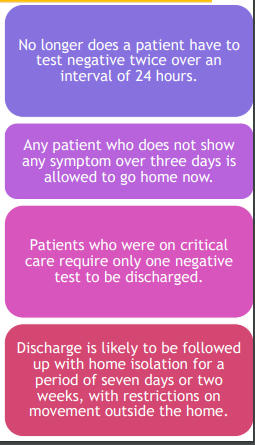Table of Contents
A case for quiet diplomacy
- On June 9, sources in the Indian Army said Indian and Chinese troops began a partial disengagement from some of the stand-off points along the Line of Actual Control (LAC) in eastern Ladakh, which has seen tensions since early May.
- That was the first official confirmation that there were ongoing multiple stand-offs along the LAC.
- The picture that emerged on June 9 indicated we are at the beginning of the process to resolve the situation, and not at the end.
- Both sides have agreed on a broad plan to defuse four of the five points of discord.


- The situation at the fifth, Pangong Lake remains uncertain, as also in Galwan valley and north Sikkim.
- The pattern of resolution of past stand-offs underlines the key role played by quiet diplomacy in unlocking complicated stand-off situations.
- Past governments have used quite diplomacy.
- “The key to arriving at a successful outcome,” Mr. Former National Security Adviser Shivshankar Menon wrote in Choices: Inside the Making of India’s Foreign Policy, “was keeping public rhetoric calm and steady, displaying strength, and giving the adversary a way out, which was our preferred solution.”
- In 2017, Indian troops crossed over into Bhutan to stop a Chinese road construction on territory India sees as Bhutanese but China claims.
- By extending the road, India argued, China was unilaterally altering the India-Bhutan-China trijunction.
- Beijing demanded an unconditional withdrawal.
- When both finally disengaged, neither divulged the terms. It would later emerge that the deal struck involved India withdrawing first.
- China then stopped construction, and the status quo at the face-off site was restored.

- The tensions on the LAC are neither the first nor likely to be the last.
- Govt. needs to keep the Opposition informed, which it is clear it hasn’t.
- Govt. needs to proactively engage with the media.
- The broader objective shouldn’t get lost in political debates.
- That objective is to ensure India’s security interests remain protected — and that the status quo on India’s borders isn’t changed by force.
Back from the brink
- The five spots include Patrolling Points 14, 15 and 17, Chushul, and the north bank of Pangong Lake.
- A broad plan has been agreed to hold a series of talks at lower ranks of Colonel, Brigadier, and Major General at four of those points in the coming week to take forward the disengagement process.
- There, however, appear to be serious differences on Pangong Lake, which may require another round of higher level talks at the Corps Commander level.
- India has made clear it will accept nothing less than restoring the status quo ante, and will not dilute its build-up in the area until and unless China draws down the artillery, bombers, rocket forces, air defence radars and jammers that it has amassed behind the frontlines on its side of the LAC.
- One important takeaway from the June 6 talks that could have a long-lasting impact is a proposal that the Corps Commanders have formal meetings once or twice a year for better interaction between the two armies at a higher level.
- If there is one thing that the recent tensions have made clear, it is the urgent need for better communication to address the strategic mistrust that prevails on both sides of the LAC.
- Ill-advised posturing at the top political levels of the Indian leadership with threats last year to reclaim Aksai Chin didn’t help either.
A better rate
- Total number of discharged people with COVID-19, from the time the first ever case was recorded in India, has exceeded the number of active cases is definitely a milestone.
- Thursaday: a total of 1,46,716 people have recovered, while the number of active cases was 1,42,697.
- Fatality rate is just about 2.8%
- Indian government revised its discharge policy, as have some other nations.

- While the natural path of this curve is upwards, any slackening here will have disastrous consequences.
- The threat of this epidemic reaching a peak and overwhelming stretched health-care resources and facilities is clear and present.
- Providing adequate facilities and easy access to emergency care services are important in the COVID Care Centres and COVID Health Centres, and adequate monitoring of home quarantined people, possibly in association with local bodies and voluntary organisations, is essential.
- Indian Council of Medical Research has asserted that India is not in community transmission of COVID-19.
- Director General of ICMR Dr Balram Bhargava said that the country has to continue with effective surveillance and containment strategies.
- He said, India is such a large country and prevalence is very low.
- Dr Bhargava informed that India’s COVID-19 cases per lakh population is the lowest in the world and the number of deaths per lakh population is also amongst the lowest in the world.
- The recovery rate of COVID-19 patients has improved to 49.21 per cent.
- On this occasion, the results of ICMR’s Population based serosurvey was released which says that 0.73 per cent of population in 83 districts where it was conducted had evidence of past exposure to Corona virus infection.
- It said, the lockdown and containment have been successful in keeping it low and preventing rapid spread.
- As per the survey, however, a large proportion of the population is still susceptible.
- The survey was conducted for COVID-19 in May this year.
- Its Part- 1 has been completed and Part-2 is ongoing.
- Dr. V. K. Paul: as per the report COVID incidents are higher in urban slums.
- He said, the infection fatality rate is 0.08 per cent which is very low.
- He also said the states can not lower their guard and need to keep on implementing effective surveillance and containment strategies.
Let’s All Do It
- In the most promising scientific news this month, a modelling study led by the University of Cambridge has made a strong case for the efficacy of facemasks.
- Homemade masks help as well.
- The study suggests an entire population wearing masks of just 75% effectiveness can bring a very high R0 of 4 to less than 1, that too without a lockdown.
- R0 is the number of people to whom an infected person passes the virus, and when this number falls below 1 it means the pandemic’s been slowed.

- The crucial message of the above study is that in this taxing situation, we can all take control in some very basic ways.
- It urges the immediate and universal adoption of facemasks by the public.
- It also helps to regularly wash hands with soap and physically distance, in particular to avoid proximity in enclosed spaces.
- But of all these the mask is the easiest to universalise in India.
- Hong Kong: close to 99% of residents have been reported to be wearing masks since early February
NEWS
- Prime Minister Narendra Modi said the country has moved from the policy of command and control to plug and play in order to prepare it for the Post COVID world.
- Addressing the Industry heads at the 95th annual plenary session of Indian Chamber of Commerce on the theme of people, planet and profit in Kolkata through video conference today, Prime Minister highlighted government’s people-centric, people-driven and planet-friendly policies.
- He said, it is the time for bold investments and bold decisions to build a globally competitive strong domestic supply chain in the country.
- Atma Nirbhar Bharat: the country is determined to convert the challenges into an opportunity and termed self-reliance as the key solution to pave path for the Post COVID world.
- Remembering Swami Vivekananda’s mantra for Indian’s to use their own produce and find markets in other countries, he termed self-reliance as the key solution for India.
- He said that Swami Vivekananda has shown the path for a Post COVID world.
- “आत्म निर्भर भारत अभियान का सीधा सा मतलब है कि भारत, दूसरे देशों पर अपनी निर्भरता कम से कम करे। हर वो चीज, जिसे Import करने के लिए देश मजबूर हैं, वो भारत में ही कैसे बने, भविष्य में उन्हीं Products का भारत Exporter कैसे बने, इस दिशा में हमें और तेजी से काम करना है।“
- Appreciating the efforts of small traders and producers, he said that when we buy local produce from them, we are not just paying them for their goods and services, but are honouring their contributions.
- Underlining the reforms of definitional change of MSME to decriminalization of provisions for the industrial sector, he said, these will pave way for better growth in the country.
- Citing the amendments in the APMC and Essential Commodity Act, the Prime Minister said these historic changes will help farmers develop a bigger and better market.
- External Affairs Ministry today said that India and China are maintaining their military and diplomatic engagements to peacefully resolve the border standoff at the earliest to ensure peace and tranquility in the border areas.
- External Affairs Ministry Spokesman Anurag Srivastava said, this is essential for the further development of India-China bilateral relations.
- Mr Srivastava said, a meeting was held between the Corps Commanders of India and China on 6th of this month in the Chushul-Moldo region.
- This meeting was in continuation of the diplomatic and military engagements which both sides have maintained to address the situation in areas along the India-China border.
- He said, it was agreed that an early resolution of the situation would be in keeping with the guidance of the leaders.
- Mr Srivastava also said that India deeply values its cultural and friendly relations with Nepal.
- The multi-faceted bilateral partnership has expanded and diversified in the recent years with increased focus and enhanced India’s assistance on humanitarian, development and connectivity projects in Nepal.
- Replying to a query pertaining to the Report on International Religious Freedom for 2019 published by the United States Department of State, Mr Srivastava said, the report is published annually by the department as part of its legal requirement to the US Congress and is an internal document of the US Government.
- The Phase-Three of Vande Bharat Mission has been initiated from today. Briefing media, External Affairs Ministry Spokesman Anurag Srivastava said, it will last till the 2nd of July.
- Phase-Three will have 432 international flights from 43 countries reaching 17 States and Union Territories.
- In this phase, there will also be 29 flights from private carriers – 24 Indigo flights, three Go Air flights and two Vistara flights.
- The number of flights from the US and Canada have also been increased given the huge demand.
- Over one lakh 70 thousand citizens have returned to India through different modes of transport in one of the world’s largest evacuation drives.
- As part of the Operation Samudra Setu under Vande Bharat Mission, INS Shardul carrying 233 Indians stranded in Iran arrived at the Porbandar Port today afternoon.
- Union Minister for Human Resource Development Ramesh Pokhriyal Nishank today virtually released India Rankings-2020 for Higher Educational Institutions in New Delhi.
- IIT, Madras retains first position in Overall Ranking as well as in Engineering.
- Indian Institute of Science, Bengaluru tops the University list. IIM, Ahmedabad tops in Management Category and AIIMS occupies the top slot in Medical category for third consecutive year.
- Miranda College retains first position amongst colleges for third consecutive year Maulana Azad Institute of Dental Sciences, Delhi secures first position in Dental category.
- Dental institutions included for first time in India Rankings-2020 .
Download Free PDF – Daily Hindu Editorial Analysis






















 WhatsApp
WhatsApp